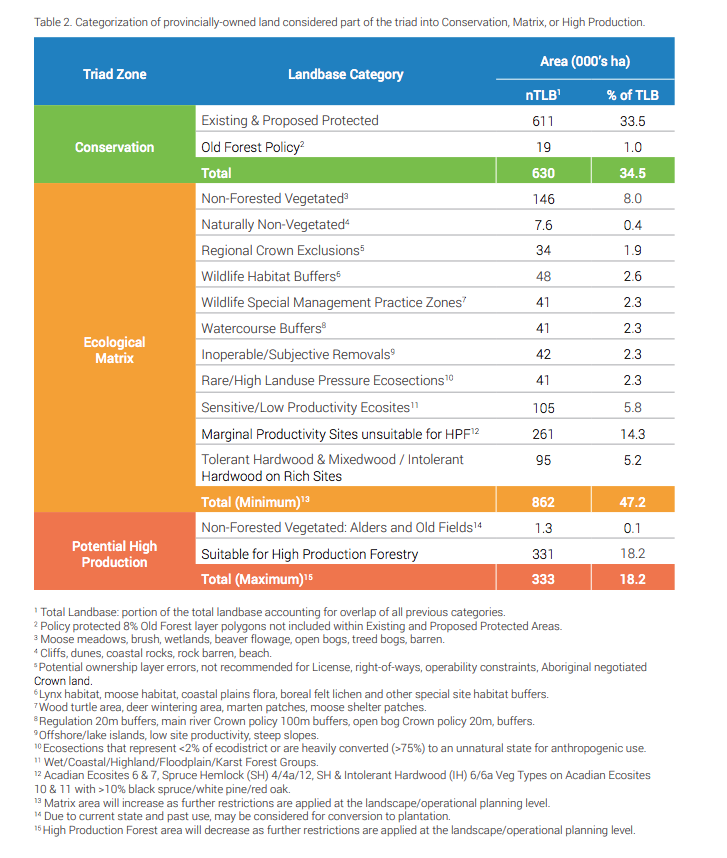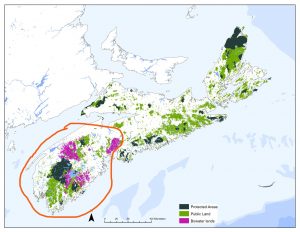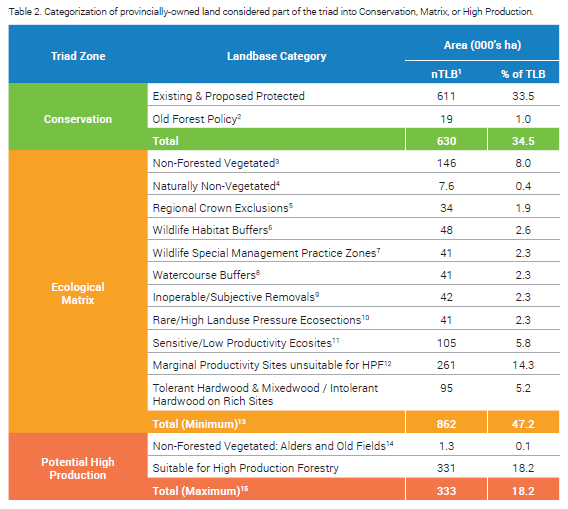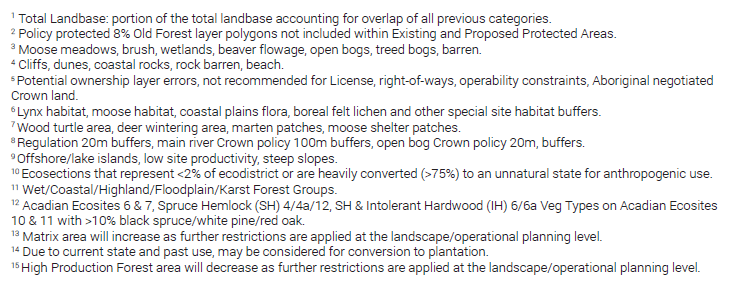UPDATE May 16, 2020: On Friday, May 15, 2020, Lands & Forestry Minister Iain Rankin was interviewed on CBC’s Information Morning (Halifax) regarding the comments of Shelly Hipson on May 11 (below) about the HPF (High Production Forestry) proposals for Crown lands. For the record and to encourage ongoing public discussion on this topic, I have posted an ‘abbreviated transcript’ of the interview with Minister Rankin as recorded by CBC, and a response of Shelly Hipson on May 16,2020 to Minister Rankin’s comments below this post.
Concludes Hipson: There are 356,000 ha of working forest in the Ecological Matrix, compared to 333,000 ha assigned to the High Production Forestry units, a roughly 50:50 split… “We are concerned about clearcutting. We are not concerned about clearcutting land where you can’t clearcut.” [In the HPF Discussion Paper, the total land area assigned to the Ecological Matrix is 47.2% of Crown Land consisting of working forest and other land use designations; the total land area assigned to HPF is 18.2%, all of it working forest or potential working forest.]
—————————

Tree Canopy Gain (blue)-most of it in recovering clearcuts, and Tree Canopy Loss (red) in NS 2001-2018; green is in forest not harvested in the last approx 50+ years. Where will the HPF sites be located?
Click on image for larger version
On CBC’s Information Morning (Halifax) this am., Shelly Hipson raised some significant concerns about the designation of Crown lands for High Production Forestry, and how those are presented to the public.
An Abbreviated Transcript* of the Interview (I have inserted the links):
CBC (Portia Clark): … The Independent Review recommended Ecological Forestry… the new plan would see some forest set aside for conservation plus an ecological area logged without clearcutting and a third area for high production plantation type forestry (HPF). In the HPF fast growing species would be grown using herbicides and fertilizers and clearcut every 30 to 45 years. Just before Covid19 hit, the province released a Discussion Paper on HPF. Shelly Hipson has had a close look at it. She manages the [public] Facebook group, People for Ecological Forestry in SW Nova Scotia.
What are the main concerns that you have is how the province has broken down the land that is available for each of the categories. Can you explain that?
SH: Sure. What we are dealing with is 1.8m ha, broken down into Conservation, Ecological Matrix and HPF. My concern are the percentages that they have used. What I hear from government, people in industry is that only 18% will be used for HPF…HPF is actually tree plantations. So they are planning to convert 330,000 ha, about 822000 acres or around 600,000 football fields of forest, so it is substantial.
My issue is that this 18% is being used as if it’s low… I and others have questioned that. The Ecological Matrix which will have low impact type of forestry is 47% and they are comparing that to the 18% in HPF…so it sounds so low.
So what they have done to beef that number up to the 47% is they have actually included things like rock barrens, beaches, coastal dunes and cliffs so we would think we would be only looking at the working forest that are actually covered by trees… you don’t really put the sand dunes and cliffs into the Ecological Matrix and say that it’s at 47%; when you start taking those things out where you can’t grow trees, it’s more of a 50-50 split between the EM and HPF.
CBC: Where is this 18% HPF land located, in highly forested good land, not dunes I assume?
SH: No they don’t get the sand dunes or the offshore islands. I haven’t seen a map. I think that’s an important question… people would want to know where those tree plantations will be where they will see clearcuts happening over and over again on a rotation of 30 years. Rural people have to live with this in their backyards…
One of the concerns many of us have is spraying of glyphosate, we are at a critical time on our planet with losses of biodiversity, so to convert 822000 acres into a plantation that will be sprayed and they don’t tell us what kind of fertilizer they will use…there are also concerns about runoff and wetlands and water systems and water tables.
If you can think back to 2012 when the province purchased the Bowater lands, 580,000 acres. This HPF.. will convert our biodiverse Acadian forest, 822000 acres of it to plantations. This land mass is bigger than the Bowater lands.
CBC: What products will come from the HPF forests?
SH: Right now as we know Northern Pulp has closed…in the discussion paper they have listed nine mills… they are growing timber for the mills, which are private companies. This is public land, it’s very important to ask the people of Nova Scotia what they want done with our resource, our forests that are keeping us sustained.. they are oxygen givers…it’s really important to consider the whole biodiversity and where we are heading.
CBC: This is a discussion paper, so what’s your sense about how important this in relation to the decisions that will be made
SH: Yes it is a discussion paper, it is on a website nobody knows about basically. I think it’s really important to take a close look at what they are doing, they started out with the HPF paper they didn’t start out with an ecological or biodiversity paper to find out where species-at-risk would need habitat or the endangered Mainland Moose which we hear now is down to 100 moose, where their concentration areas are…
Many people have got to the point that they really don’t trust what is happening…they play with these numbers that make it sound like it’s “only 18.2%” …and it’s more than the Bowater lands… Where is the transparency? They are still on their same agenda, I don’t see there has been any changes in their practices in the woods…
CBC… we will put a link to the discussion paper @informationmorning on Twitter
https://twitter.com/infomorning/
*A note about the “abbreviated transcripts”. I post “abbreviated transcripts” of interviews on radio and TV as a matter of record, a prime objective of this blog being to keep track of Nova Scotia forestry in the news (see About this site). One can listen to the interviews, but in this rushed world it’s faster to read the transcript, albeit you miss some of the nuances. It is not Hansard, and for the sake of getting though it in less than a day, the transcript is not always precise, but I attempt not to change the essence of what is said in any way, and in most cases one can check out the original audio files or videos. I also do it because it makes me listen carefully to what is being said, whether I like what’s being said or not.
Some related posts, links
Nervousness about forestry practices in Nova Scotia continues 10May2020
Post on NSFN, May 10, 2020
HFN Conservation Committee comments on High Production Forestry Discussion Paper
Post on Halifax Field Naturalists website, Apr 2, 2020
Why we need a Precautionary Biodiversity Landscape Plan for Nova Scotia 16Mar2020
Post on NSFN Mar 16, 2020
Protecting supply of “wood” but not necessarily big trees from Nova Scotia’s Crown lands remains the priority at L&F 15Mar2020
Post on NSFN Mar 15, 2020
Addie & Fred Campaigne: Nova Scotia’s High Production Forestry Phase 1 omits consideration of Species-At-Risk and ecosystems 6Mar2020
Post on NSFN, March 6, 2020
Nova Scotia ‘High Production Forestry Discussion paper’ now available, March 13 is deadline for public comment 21Feb 2020
Post on NSFN, Feb 21, 2020
L&F/Independent Review on the Triad:
– An Independent Review of Forest Practices in Nova Scotia: Executive Summary, Conclusions and Recommendations
By William Lahey. 82 pages– An Independent Review of Forest Practices in Nova Scotia: Addendum.
In particular, view Ch 13 Balanced Forestry and the Triad, by Robert Seymour, pp 61-86
TRIAD – A NEW VISION
by Dr. Graham Forbes, 2019.
——————————
On High Production Forestry in Nova Scotia… continued
On Friday, May 15, 2020, Lands & Forestry Minister Iain Rankin was interviewed on CBC’s Information Morning (Halifax) regarding the comments of Shelly Hipson (above, on May 11, 2020) about the HPF (High Production Forestry) proposals for Crown lands. Shelly Hipson responded in turn.
Below is an ‘abbreviated transcript’ of the CBC Interview with Minister Rankin, followed by the response of Shelly Hipson as posted on People for Ecological Forestry in Southwest Nova Scotia (May 16, 2020)
CBC: This week I spoke with Shelly Hipson…she is concerned about the way land is being sectioned off for HPF, here is a bit of the interview:
SH: What we are dealing with is 1.8m ha, broken down into Conservation, Ecological Matrix and HPF. My concern are the percentages that they have used. What I hear from government, people in industry is that only 18% will be used for HPF…HPF is actually tree plantations. So they are planning to convert 330,000 ha, about 822000 acres or around 600,000 football fields of forest, so it is substantial.
My issue is that this 18% is being used as if it’s low… I and others have questioned that. The Ecological Matrix which will have low impact type of forestry is 47% and they are comparing that to the 18% in HPF…so it sounds so low.
What they have done to beef that number up to the 47% is they have actually included things like rock barrens, beaches, coastal dunes and cliffs so we would think we would be only looking at the working forest that are actually covered by trees… you don’t really put the sand dunes and cliffs into the Ecological Matrix and say that it’s at 47%; when you start taking those things out where you can’t grow trees, it’s more of a 50-50 split between the EM and HPF.
CBC: …Iain Rankin is the Minister of Lands and Forestry; What can you tell us about where that 18% is?
Iain Rankin (IR): To start, this is a discussion paper… all Nova Scotians had an opportunity to give feedback…..
It’s important to correct the numbers, the cliffs dines and those types of materials take up only 1% of the area proposed. The reality is that the whole landscape needs to be identified somewhere, there are non-forested lands out there and it’s clear that the ecological matrix was the most logical best fit…
CBC: Where will the HPF be?
…This is the beginning…land used for agriculture, close to mills etc. It’s being proposed. We will be scaling back. 18% is the maximum.
CBC: Will the public have a say in where the HPF are located?
IR: Yes… this is the stage where we are getting feedback on the criteria; we had over 70 submissions and 500 written comments. We will have targeted engagement sessions..through the spring and into the summer, then we will be looking at phase 2 in the fall, the actual site selection.. it’s important that this work happens with work on the FMG… I know some people only like one leg of the triad… but we need to work on all 3 legs or the system or it doesn’t work…we need to put equal tension on all 3 legs.
CBC: Does “targeted” mean “invite-only” or will they truly be open to people, does that just mean they will be in areas where HPF is being considered?
IR: We haven’t finalized how the platform will work in that phase.. I have a Ministerial Advisory Committee…made up of all interest, stakeholders….that’s where I am getting a lot of my advice, that work is continuing just and last week the committee met…
CBC: There will be glyphosate and fertilizer used in the HPF, there could be problems with runoff, …glyphosate has been linked with carcinogen by the WHO.
IR: I think we have spoken on that before. I need to point to the Independent Report… There are trade-offs in some areas…if we want to grow trees and make the most efficient use, part of it is the herbicide application… use of fertilizer… it is being monitored…only approved fertilizers will be used. It’s similar to amendments on farmlands. It is treating that very small portion of the Crown land as crops… this is the whole concept so that we can institute a silvicultural system on a wider landscape that focuses on multi-aged management so we can restore our Acadian type forest that we had 100s of years ago.
CBC: Minister Rankin, I am sure we will have further discussions…
END
Shelly Hipson commented in turn on People for Ecological Forestry in Southwest Nova Scotia (May 16, 2020):
ON FRIDAY MINISTER IAIN RANKIN ATTEMPTED TO DISCREDIT “PEOPLE FOR ECOLOGICAL FORESTRY IN SOUTHWEST NOVA SCOTIA” ABOUT HIGH PRODUCTION FORESTRY ON CBC INFORMATION MORNING.
Here is the link to that interview: https://www.cbc.ca/l…/live-radio/1-27-information-morning-ns
If he didn’t get the point, all he had to do was ask.
FIRST –
William Lahey wrote “An Independent Review of FOREST PRACTICES in Nova Scotia. SO WE are talking about THE WORKING FORESTS.In his interview, he claims that “it is important to correct the numbers” – that “cliffs, dunes, and those types of materials, rocks, barrens and beach.” are only 1 percent.
So what the Minister did – he did not reflect on the point that we were making – That there is a bunch of land in the ecological matrix category that can not be clearcut because there are no trees – it’s illegal – or you can’t access –
And he only added the hectares of the “cliffs , dunes, rocks, barrens and beach” that we mentioned in the interview – and gave the percentage of 1 percent.
Good try Minister Rankin – but we have a lot of smart cookies on our team that can see through this tactic. We’ve been down this road before with politicians.
So we’ll try again Minister Rankin, since it appears that you may have been confused and unable to grasp our concerns explained in the interview – or you may have chose once again not to listen to our concerns about clearcutting and wanted to misguide the public.
——————————————————————————–
Under the ecological matrix category your department has put 506,000 hectares out of 862,000 hectares of land that is
NOT FORESTED
THERE ARE NO TREES
THERE IS NO VEGETATION
IT IS NOT RECOMMENDED FOR FORESTRY
NO ONE IS PERMITTED AND IT IS ILLEGAL TO CUT TREES
IT’S IMPOSSIBLE TO ACCESS WITH HEAVY EQUIPMENT
——————-SO———————-
TOTAL ECOLOGICAL MATRIX IS 862,000 HECTARES
TOTAL LAND THAT YOU CAN’T LOG ON BUT IS INCLUDED IN THE ECOLOGICAL MATRIX IS 506,000 HECTARES
…THAT LEAVES 356,000 HECTARES OF FORESTED LAND IN THE ECOLOGICAL MATRIX THAT HAS A FOREST.
(kind of important point when you want to see a dramatic reduction in clearcutting – they have to have a forest to cut)
THE POTENTIAL SET ASIDE FOR HIGH PRODUCTION FORESTRY IS 333,000
*****Please note that in the Table only 0.1% of High Production Forestry land is Non-Forested Vegetated Alders and old fields BUT you will hear the Minister point this out as the focus for High Production Forestry*******
In the Discussion Paper the Department has
ECOLOGICAL MATRIX 862,000 HECTARES 47%
HIGH PRODUCTION FORESTRY 333,000 HECTARES 18%When we consider only the working forest or forested land the
ECOLOGICAL MATRIX is 356,000 HECTARES
HIGH PRODUCTION FORESTRY: 333,000 HECTARESIt is roughly a 50-50 split…
Mr. Rankin, and those interested: we’ll list the categories we feel should be removed from the Ecological FORESTY Matrix below.
You can not do FORESTRY ON THE FOLLOWING THAT HAVE BEEN INCLUDED IN THE ECOLOGICAL MATRIX.
Why are we pointing this out?
Because we are concerned about clearcutting and you can’t clearcut on ANY OF THIS land listed below but is included.
Here is a recap of our concerns with Table 2:
Non-Forested Vegetated
(IT’S NON FORESTED – THERE ARE NO TREES)
Moose meadows, brush, wetlands, beaver flowage, open bogs, treed bogs, barren.
146,000 hectares 8.0 percentNaturally Non-Vegetated
(IT’S NON FORESTED – THERE IS NO VEGETATION)
Cliffs, dunes, coastal rocks, rock barren, beach
7,600 hectares 0.4 percentRegional Crown Exclusions
(IT’S NOT RECOMMENDED FOR FORESTRY)
Potential ownership layer errors, not recommended for License, right-of-ways, operability constraints, Aboriginal negotiated Crown land.
34,000 hectares 1.9 percentWildlife Habitat Buffers
(YOU ARE NOT PERMITTED TO CUT TREES)
Lynx habitat, moose habitat, coastal plains flora, boreal felt lichen and other special site habitat buffers.
4,800 hectares 2.6 percentWildlife Special Management Practice Zones
(YOU ARE NOT PERMITTED TO CUT TREES)
Wood turtle area, deer wintering area, marten patches, moose shelter patches.
4,100 hectares 2.3 percentWatercourse Buffers
(IT’S ILLEGAL TO CUT TREES)
Regulation 20m buffers, main river Crown policy 100m buffers, open bog Crown policy 20m, buffers.
4,100 hectares 2.3 percentInoperable/Subjective Removals
(IT’S IMPOSSIBLE TO CUT TREES)
Offshore/lake islands, low site productivity, steep slopes.
4,200 hectares 2.3 percentRare/High Landuse Pressure Ecosections
(THERE ARE NO TREES)
Ecosections that represent <2% of ecodistrict or are heavily converted (>75%) to an unnatural state for anthropogenic use.
4,100 hectares 2.3 percentSensitive/Low Productivity Ecosites
(THERE ARE NO TREES)
Wet/Coastal/Highland/Floodplain/Karst Forest Groups.
105,000 hectares 5.8 percentTHAT TOTALS 506,600 HECTARES OF LAND THAT WOULD BE CONSIDERED NON-WORKING FOREST. We are concerned about clearcutting. We are not concerned about clearcutting land where you can’t clearcut.
THAT LEAVES THE FOLLOWING WITH TREES IN THE ECOLOGICAL MATRIX
Marginal Productivity Sites unsuitable for HPF
Acadian Ecosites 6 & 7, Spruce Hemlock (SH) 4/4a/12, SH & Intolerant Hardwood (IH) 6/6a Veg Types on Acadian Ecosites
10 & 11 with >10% black spruce/white pine/red oak.
261,000 hectares 14.3 percentTolerant Hardwood & Mixedwood / Intolerant
Hardwood on Rich Sites
9,500 hectares 5.2 percent356,000 HECTARES
The Department of Lands and Forestry has already changed the definition of clearcut – then removed the word clearcut – NOW you are ‘giving us’ the land that you can’t clearclut on because – you just can’t.
One would think the minister would be able to see through all of this – as we do – and side with the people who voted him in – just once – instead of trying his best to make us look like fools.
But nope – he’ll get shifted from his Minister position like John McDonell did when he stood up for a reduction in clearcutting under the NDP.
Because guess what – there are a certain few high up in this department running this show and doing whatever they can to hand over clearcut after clearcut to their industry brothers.




